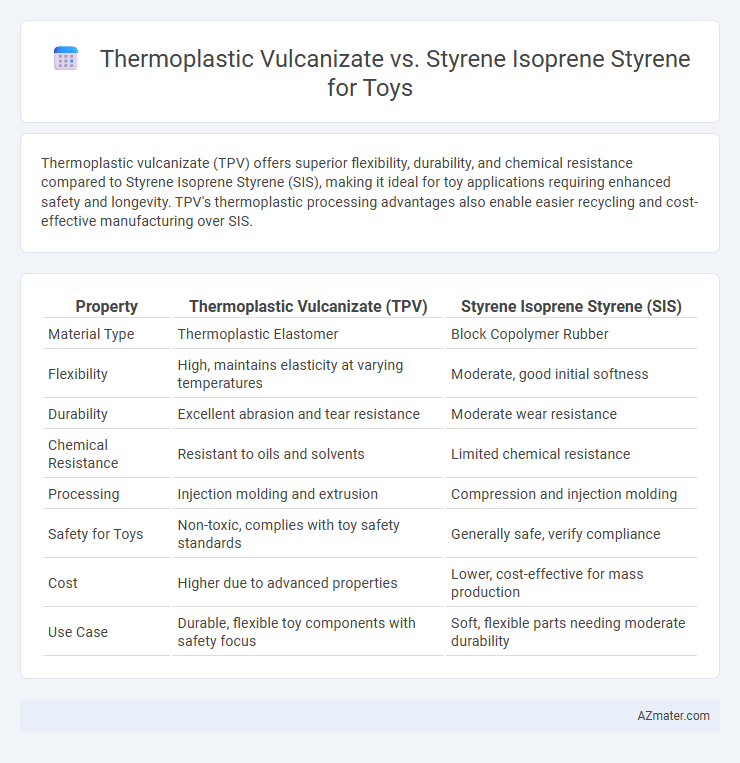Thermoplastic vulcanizate (TPV) offers superior flexibility, durability, and chemical resistance compared to Styrene Isoprene Styrene (SIS), making it ideal for toy applications requiring enhanced safety and longevity. TPV's thermoplastic processing advantages also enable easier recycling and cost-effective manufacturing over SIS.
Table of Comparison
| Property | Thermoplastic Vulcanizate (TPV) | Styrene Isoprene Styrene (SIS) |
|---|---|---|
| Material Type | Thermoplastic Elastomer | Block Copolymer Rubber |
| Flexibility | High, maintains elasticity at varying temperatures | Moderate, good initial softness |
| Durability | Excellent abrasion and tear resistance | Moderate wear resistance |
| Chemical Resistance | Resistant to oils and solvents | Limited chemical resistance |
| Processing | Injection molding and extrusion | Compression and injection molding |
| Safety for Toys | Non-toxic, complies with toy safety standards | Generally safe, verify compliance |
| Cost | Higher due to advanced properties | Lower, cost-effective for mass production |
| Use Case | Durable, flexible toy components with safety focus | Soft, flexible parts needing moderate durability |
Overview of Thermoplastic Vulcanizate (TPV) and Styrene Isoprene Styrene (SIS)
Thermoplastic Vulcanizate (TPV) is a rubber-like material known for its excellent elasticity, chemical resistance, and thermal stability, making it ideal for durable, safe toy applications that require impact resistance and flexibility. Styrene Isoprene Styrene (SIS) is a block copolymer offering high tensile strength, good abrasion resistance, and a soft, rubbery feel, suitable for toys that demand softness and surface grip. TPV outperforms SIS in heat resistance and long-term durability, while SIS provides superior tactile softness and ease of processing in toy manufacturing.
Key Material Properties: TPV vs SIS
Thermoplastic vulcanizate (TPV) offers superior elasticity, chemical resistance, and impact toughness compared to Styrene Isoprene Styrene (SIS), making it ideal for durable, flexible toy components. TPV exhibits enhanced thermal stability and excellent weather resistance, ensuring long-lasting performance under varied environmental conditions. SIS provides good processability and softness but lacks the mechanical strength and resilience required for high-stress toy applications where safety and durability are critical.
Safety and Non-Toxicity Considerations for Toys
Thermoplastic vulcanizate (TPV) offers superior safety and non-toxic properties for toys compared to Styrene Isoprene Styrene (SIS) due to its enhanced chemical stability and resistance to degradation, minimizing harmful substance release. TPV is free from harmful plasticizers and phthalates, commonly found in SIS, reducing risks of toxicity and allergic reactions in children. Regulatory compliance with ASTM F963 and EN71 standards is more consistently met by TPV, ensuring safer play environments and prolonged use without health hazards.
Flexibility and Softness in Toy Applications
Thermoplastic vulcanizate (TPV) offers superior flexibility and softness compared to Styrene Isoprene Styrene (SIS), making it ideal for toy applications requiring enhanced durability and comfort. TPV's unique cross-linked elastomeric structure ensures excellent resilience and a softer feel, which improves tactile interaction and safety for children. SIS, while providing good elasticity, tends to be stiffer and less flexible, limiting its effectiveness in toys demanding extended flexibility and gentle touch.
Durability and Resistance to Wear
Thermoplastic vulcanizate (TPV) exhibits superior durability and enhanced resistance to wear compared to Styrene Isoprene Styrene (SIS), making it more suitable for long-lasting toy components. TPV's dynamic vulcanization process results in a robust elastomeric phase that resists abrasion, repeated flexing, and environmental stress cracking effectively. In contrast, while SIS offers good elasticity and softness, its wear resistance is lower, leading to faster degradation under mechanical stress in toys subjected to frequent handling and impact.
Processing Methods: Ease of Manufacturing
Thermoplastic vulcanizate (TPV) offers superior ease of manufacturing for toys due to its excellent melt processability and compatibility with injection molding and extrusion techniques, allowing for faster cycle times and reduced tooling wear. Styrene Isoprene Styrene (SIS), while providing good elasticity and impact resistance, requires more precise temperature control and longer curing cycles during thermoplastic processes, potentially increasing production complexity. TPVs also allow for easier recycling and reprocessing, enhancing overall manufacturing efficiency compared to SIS-based materials.
Cost Comparison: TPV vs SIS for Toy Production
Thermoplastic vulcanizates (TPVs) generally cost more upfront than Styrene Isoprene Styrene (SIS) due to their advanced blend of rubber and plastic properties, which enhance durability and flexibility in toy production. SIS offers a lower material cost and ease of processing, making it attractive for budget-conscious toy manufacturers, but may lack the longevity and mechanical resilience provided by TPVs. When evaluating overall cost-effectiveness, manufacturers should consider not only material price but also lifecycle durability, molding efficiency, and end-product performance in safety and tactile quality.
Environmental Impact and Recyclability
Thermoplastic vulcanizate (TPV) offers superior environmental benefits over Styrene Isoprene Styrene (SIS) due to its enhanced recyclability and lower carbon footprint in manufacturing processes. TPV materials can be remelted and reprocessed multiple times without significant degradation, reducing landfill waste and supporting circular economy initiatives in toy production. In contrast, SIS's limited recyclability and reliance on petroleum-based components contribute to greater environmental challenges and hinder sustainable toy manufacturing.
Colorability and Aesthetic Options for Toys
Thermoplastic vulcanizate (TPV) offers superior colorability and aesthetic options for toys compared to Styrene Isoprene Styrene (SIS) due to its enhanced compatibility with a wide range of pigments and dyes, resulting in vibrant, consistent colors. TPVs maintain color stability and resist fading over time, making them ideal for toys exposed to various environmental conditions. SIS, while flexible and soft, typically exhibits limited color vibrancy and less durability in color retention, restricting its aesthetic versatility in toy applications.
Best Use Cases: Choosing TPV or SIS for Different Toys
Thermoplastic vulcanizate (TPV) offers excellent flexibility, chemical resistance, and durability, making it ideal for toys requiring high impact resistance and long-term wear, such as teething rings and outdoor play equipment. Styrene Isoprene Styrene (SIS) demonstrates superior elasticity and softness, suitable for toys needing a softer touch, like squeeze toys and stress balls. Selecting TPV or SIS depends on the toy's functional demands, with TPV preferred for rugged applications and SIS favored for tactile, squeezable designs.

Infographic: Thermoplastic vulcanizate vs Styrene Isoprene Styrene for Toy
 azmater.com
azmater.com